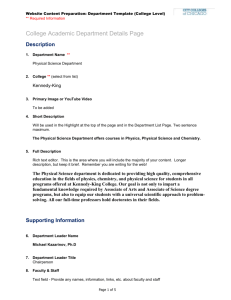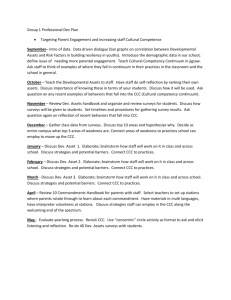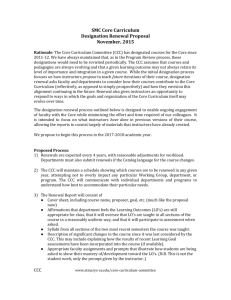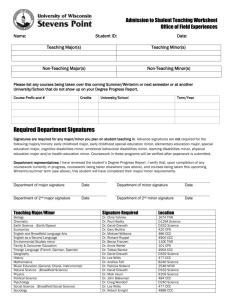Response to Examiner`s Additional Questions Sent 21.10.2013
advertisement
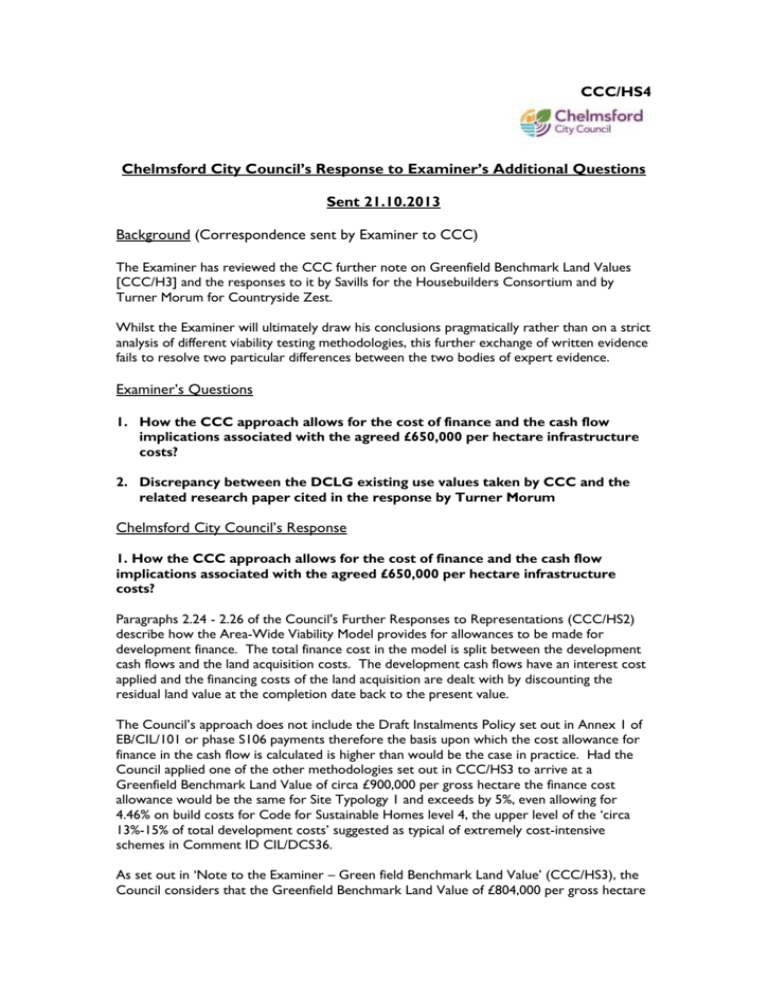
CCC/HS4 Chelmsford City Council’s Response to Examiner’s Additional Questions Sent 21.10.2013 Background (Correspondence sent by Examiner to CCC) The Examiner has reviewed the CCC further note on Greenfield Benchmark Land Values [CCC/H3] and the responses to it by Savills for the Housebuilders Consortium and by Turner Morum for Countryside Zest. Whilst the Examiner will ultimately draw his conclusions pragmatically rather than on a strict analysis of different viability testing methodologies, this further exchange of written evidence fails to resolve two particular differences between the two bodies of expert evidence. Examiner’s Questions 1. How the CCC approach allows for the cost of finance and the cash flow implications associated with the agreed £650,000 per hectare infrastructure costs? 2. Discrepancy between the DCLG existing use values taken by CCC and the related research paper cited in the response by Turner Morum Chelmsford City Council’s Response 1. How the CCC approach allows for the cost of finance and the cash flow implications associated with the agreed £650,000 per hectare infrastructure costs? Paragraphs 2.24 - 2.26 of the Council's Further Responses to Representations (CCC/HS2) describe how the Area-Wide Viability Model provides for allowances to be made for development finance. The total finance cost in the model is split between the development cash flows and the land acquisition costs. The development cash flows have an interest cost applied and the financing costs of the land acquisition are dealt with by discounting the residual land value at the completion date back to the present value. The Council’s approach does not include the Draft Instalments Policy set out in Annex 1 of EB/CIL/101 or phase S106 payments therefore the basis upon which the cost allowance for finance in the cash flow is calculated is higher than would be the case in practice. Had the Council applied one of the other methodologies set out in CCC/HS3 to arrive at a Greenfield Benchmark Land Value of circa £900,000 per gross hectare the finance cost allowance would be the same for Site Typology 1 and exceeds by 5%, even allowing for 4.46% on build costs for Code for Sustainable Homes level 4, the upper level of the ‘circa 13%-15% of total development costs’ suggested as typical of extremely cost-intensive schemes in Comment ID CIL/DCS36. As set out in ‘Note to the Examiner – Green field Benchmark Land Value’ (CCC/HS3), the Council considers that the Greenfield Benchmark Land Value of £804,000 per gross hectare provides a robust and credible value. The finance allowances are also considered to be robust and do not materially alter the viability of relevant Site Typologies if calculated using alternative approaches to achieve a similar benchmark land value that represents a substantial uplift above current use values. Appendix 4 of the Council’s Further Responses to Representations (CCC/HS2) includes a Greenfield site in development and clearly demonstrates that a CIL charge of £125 per sqm is merely equivalent to the planning contributions already secured from a typical Greenfield site in development. As a percentage of gross development value, the CIL charge at £125 per sqm does not exceed 3.48% on Greenfield sites and in practice will only apply to approximately 2,000 dwellings of which only 15% will be delivered on Greenfield sites across the City area, and therefore cannot put the delivery of the Plan at risk, especially given the Council will not implement CIL until the Section 106 agreement with Countryside Zest relating to the resolution to grant planning permission for 3,600 new homes in North East Chelmsford is finalised. 2. Discrepancy between the DCLG existing use values taken by CCC and the related research paper cited in the response by Turner Morum The Council has applied the ‘typical’ figure reported on page 7 of the Research Paper ‘Cumulative impacts of regulation on house builders and landowners’ by Chris Hill of Turner Morum, which relates to a gross site area rather than the net developable derived figure cited by Turner Morum and referred to on page 8 of the same Research Paper. The Research Paper states that typically Turner Morum expect to see figures of circa £100,000 to £150,000 per gross acre, the lower end of which is equal to £247,097 per gross hectare. The Council has relied upon the ‘typical minimum threshold’ figure of £247,000 per gross hectare, which as stated in paragraph 4.2 of CCC/HS3 is in common with other local authorities in the region such as East Cambridgeshire (£250,000 per gross hectare), Bedford (£247,000 per gross hectare) and Waveney (£200,000 per gross hectare) In the absence of any evidence on benchmark land values being provided by the development industry at any point through the consultation, engagement and examination process, the benchmark level produced by the Council’s approach and alternatives set out in CCC/HS2 is considered sound. Examiner’s Note: Given that the response given by CCC is no more than clarification and in effect meets the CCC right of final reply, the Examiner is not seeking any further comments from any representors.


